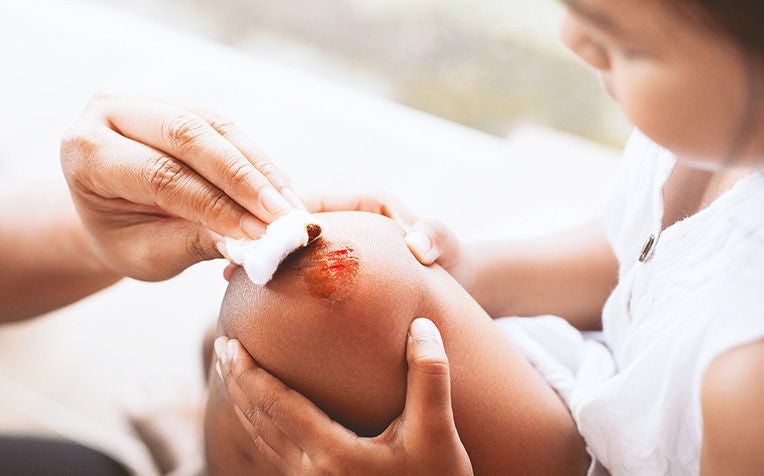
Accidents at home can happen anytime so it is important to know how to treat common minor injuries.
No matter how careful you can be at home, there will still be times when you or a loved one will experience some common injuries like cuts, burns and sprains. In such instances, stay composed and follow these basic tips before going to see a doctor.
Why you need a first aid box at home
First aid serves as immediate care or assistance given to an injured person to prevent escalation of injury. It prevents any injury from getting worse before getting any medical help or consultation.
“It is always good to have a basic first aid box at home. These boxes are usually pre-packed with essential items,” advises Wong Vern Tym, Nurse Clinician at Outram Community Hospital (OCH), under SingHealth Community Hospitals (SCH), a member of the SingHealth group.
Vern Tym also recommends checking the items inside the first aid box on a monthly basis for expiry. Alternatively, you can stock your own first aid box by buying these items off the shelf. Place your first aid box in a familiar spot at home so everyone knows where to find it.
Items a first aid box should contain include:

Non-stick sterile dressing | 
Antiseptic ointment |

| 
Sterile cotton gauze |

Crepe bandage |
|
Photos are for illustration purposes only. Items sold at pharmaceutical outlets may differ.
Tips to handle minor injuries
Knowing how to perform first aid as soon as possible from the time of injury can help prevent a minor injury from progressing into a major one.
1. Scalds / Burns
Remove any items or accessories near site of injury such as watch or jewellery. However do not remove if the item is stuck to the skin as this will worsen the situation.
Place the scalded area under running tap water for 10-20 minutes. Avoid placing ice cubes or ice water as the sudden change in temperature may worsen the situation. Plus, the ice could have been in the freezer next to your uncooked food and may contain bacteria.
Dab dry the wet areas surrounding the injury with a clean cloth. Avoid using fibrous items such as tissue, which may stick on the scalded area.
Resist from popping any blisters that may form, the intact skin serves as protection from getting an open wound infection.
Do not apply any type of ointment, cream or “home remedies” such as toothpaste that is not prescribed by a doctor. Incorrect medication will slow the release of heat from the scalded area and prolong injury.
Cover the scalded area loosely with non-stick dressing or clean plastic cling wrap.
Consult a doctor if redness or pain continues for more than a few hours.
Visit a doctor immediately after application of first aid, if the
Scalded area is on hand, face / head, genitals.
Scalded area has brown / black / white patches.
Injured person experiences an electrical or chemical burn.
Injured person experiences breathing issues.
Injured person does not experience pain in the injured area.
Injured person has an underlying medical condition (example: diabetes).
2. Cuts
Wash the injured area with soap and water to remove any debris (if possible).
Dab dry with clean cloth. Avoid using fibrous items such as tissue, which may stick on the injury and worsen it.
Cover injured area with a clean cloth and apply pressure for about 5 minutes.
Check the injured area. Proceed with second application of pressure for another 5 minutes if bleeding still occurs.
You can apply an antiseptic ointment before covering the cut with a band-aid or non-stick dressing.
Visit a doctor immediately after application of first aid, if
Bleeding continues after second application of pressure.
It was over 5 years ago that the person with the cut had a Tetanus injection.
Bones / muscles / tendons / fat can be seen from the cut. This indicates a deep cut that may require suturing.
Redness surrounding the injured area does not subside, or appears to be worsening.
The injured person develops a fever (infection may have occurred).
The injured person experiences numbness in the injured area (infection may have set in, or a nerve may have been injured).
The injured person has an underlying medical condition (example: diabetes).
3. Sprains
Rest / immobilise the sprained area to prevent it from worsening.
Place ice on the sprained area for not more than 20 minutes. It can be done every three hours to relief some swelling and pain.
Bandage the sprained area to keep it immobilised and supported. Do not wrap too tightly as this constricting effect may impede blood circulation.
Raise the sprained area when possible as it will help in blood circulation and reduce swelling. For example, place a pillow to support ankle / leg when sleeping or elevate legs on another chair when sitting down.
Visit a doctor immediately after application of first aid if
The injured person develops a fever.
Redness surrounding the injured area is not subsiding or getting worse.
Sprained area is cool to the touch, even when no ice pack has not been applied or between ice pack applications.
The injured person experiences numbness or sharp pain on the sprained area.
Pain / swelling does not get better or has increased.
The injured person is unable to exert pressure on the injured area (example: cannot stand or walk).
See how to treat burns, cuts and sprains in this video:
Ref: L20
Check out other articles on first aid:
When to Go to the A&E (Accident & Emergency)
Home Emergency Kit: What Every Home Should Have
First Aid Home Remedies: Facts vs Myths
Contributed by



















 Get it on Google Play
Get it on Google Play